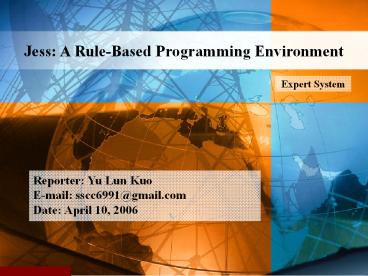Jess: A Rule-Based Programming Environment - PowerPoint PPT Presentation
Title:
Jess: A Rule-Based Programming Environment
Description:
... Based Programming Environment. Reporter: Yu Lun Kuo. E-mail: sscc6991_at_gmail. ... to let a program perform the basic collection operations on the working memory ... – PowerPoint PPT presentation
Number of Views:79
Avg rating:3.0/5.0
Title: Jess: A Rule-Based Programming Environment
1
Jess A Rule-Based Programming Environment
Expert System
- Reporter Yu Lun Kuo
- E-mail sscc6991_at_gmail.com
- Date April 10, 2006
2
Why Expert System
- Question of project developer
- Program algorithm Data Structure (Hard)
- Software Engineering
- Demand ? Design ? Coding (Demand Phase)
- Programmer
- Expert Systems
- Rule-based computer programs that capture the
knowledge of human experts in their own fields of
experience
3
Rules
- A rule is a kind of instruction or command that
applies in certain situations - Rules are a lot like the if-then statements of
traditional programming languages - if part of a rule is often called its left-hand
side - then part of a rule is often called its
right-hand side - A rule-based system is a system that uses rules
to derive conclusions from premises
if predicate or premises then
actions or conclusions
4
Rule Engine
- A rule engine doesnt contain any rules until
they are programmed in - A rule engine knows how to follow rules, without
containing any specific knowledge itself - deployment environment
5
Architecture of a Rule-Based System
- A typical rule engine contains
- Inference engine
- Forward Chaining LISP, CLIPS
- Backward Chaining - PROLOG
- Rule base (knowledge base)
- Working memory (fact base)
- Inference engine consists of
- Pattern matcher
- Agenda
- Execution engine
6
Pattern Matcher
- The working memory contains thousands of facts,
and each rule has two or three premises - The pattern matcher need to search through
millions of combinations of facts to find those
combinations that satisfy rules - All the rules are compared to working memory
- Decide which ones should be activated during this
cycle
7
Agenda
- Inference engine figures out which rules should
be fired, it still must decide which rule to fire
first - The list of rules that could potentially fire is
stored on the agenda - Ex.
Give high priority
8
Execution Engine
- The execution engine is the component of a rule
engine that fires the rules - Some modern rule engines offer a complete
programming language you can use define - What happen when a give rules fires
9
Conflict Set
Conflict Resolution
Fired
10
(No Transcript)
11
Jess (Java Expert System Shell)
- The Java Rule Engine API defined by the
javax.rules package - A standard enterprise API for accessing rule
engines - Site http//www.jcp.org/jsr/detail/94.jsp
- Jess rule engine
- A rule engine and scripting language developed at
Sandia National Laboratories in Livermore,
California in the late 1990s - It can access to all of Javas powerful APIs for
networking, graphics, database access, and so on
12
Jess (Cont.)
- The Jess language can directly access all Java
classes and libraries - This allows you to experiment with Java APIs
interactively and build up large programs
incrementally - Jess is therefore useful in a wide range of
situations - Jess can be used in command-line applications,
GUI applications, servlets, and applets.
13
- The most important step in developing a Jess
application is to choose an architecture - Pure Jess language, with no Java code
- Pure Jess language, but the program accesses Java
APIs - Mostly Jess language code, but with some custom
Java code in the form of new Jess commands
written in Java - Half Jess language code, with a substantial
amount of Java code providing custom commands and
APIs. Jess provides the main() function - Half Jess language code, with a substantial
amount of Java code providing custom commands and
APIs. You write the main() function - Mostly Java code, which loads Jess language code
at runtime - All Java code, which manipulates Jess entirely
through its Java API
14
Scripting Java with Jess
- From Java code, you can access all parts of the
Jess library - Easy to embed Jess in any Java application
- Use Jess for experimenting with Java APIs
- Jess is therefore a kind of scripting language
for Java - You can create the windows, buttons, and other
graphical components with a few lines of Jess code
15
Representing facts in Jess
- The contents of Jesss working memory are held in
your computers RAM - Most other constructs in Jess, facts are stored
as lists - Jess offers a set of functions to let a program
perform the basic collection operations on the
working memory - add, remove, modify, duplicate
16
Working memory
- assert Add facts to working memory
- Clear Clears all of Jess
- Deffacts Defines the initial contents of
working memory - Facts Display the content of working memory
- Reset Initializes the working memory
- Retract Removes facts from working memory
- Watch Tells Jess to print diagnostics when
interesting things happen































